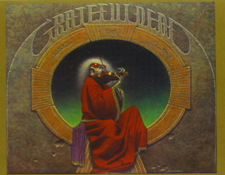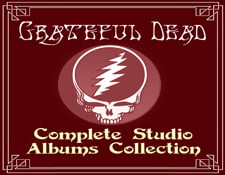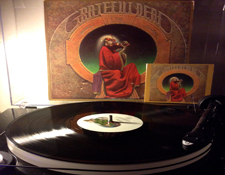It’s the time of year for saving money!
This 1975 album by The Grateful Dead, Blues For Allah, has always held a curious spot in the hearts of many a Dead Head. Speaking of it in LP terms for a moment, “Side One” was just about as perfect a statement as the band ever made in the studio, with exemplary songs, performances and sound quality. “Side Two,” starts out strong with “Crazy Fingers” and then moves into the gorgeous instrumental “Sage & Spirit.” After that, the last 15 minutes of the album were often considered something of a let down as the band indulged in an extended mind trip song cycle kicking off with the dissonant-seeming title track.
 On the original LP, that song cycle wasn’t an particularly good trip, with its quiet introspective periods that at times got lost in the noise floor of the average mid-70s turntable and hi fi set up. Also, those LP pressings, by United Artists, weren’t the best and some were downright noisy.
On the original LP, that song cycle wasn’t an particularly good trip, with its quiet introspective periods that at times got lost in the noise floor of the average mid-70s turntable and hi fi set up. Also, those LP pressings, by United Artists, weren’t the best and some were downright noisy.
A lot of mid-70s vinyl was pretty weak due to the oil crisis and cost cutting measures being taken by many a company — one of the reasons I started collecting “original” pressings of older albums in the first place actually… but I digress…
Anyhow, the potential for appreciating this rather challenging piece of music that was decidedly not rock, jazz, blues, folk, country or whatever after all the prior groovy melodicism was difficult.
Most times people would take the album off once “Sage & Spirit” had played; some like me would exit right after “Crazy Fingers,” frankly.
So I approached this review with a bit of trepidation.
Fortunately, this process has been a joy of rediscovery!
First off, after washing my original mid-70s pressing of Blues For Allah, and realizing that I was playing it for the first time on my now-not-quite-so-new turntable — a Music Hall MMF 7.1 — I immediately sensed that I was really very much hearing the album in a new way. The music was jumping out of my speakers and the noise floor — while still palpable — was disappearing. So the album sounded much less murky than I remembered and all that brilliant musicianship really shines gloriously. I can imagine that perhaps one of the super deluxe LP reissues might sound real nice.
Playing the 2004 CD reissue (from the Beyond Description boxed set), Blues For Allah sounds real solid as CDs go. But there is an undeniable brittleness in the high end that, frankly, tweaks my ears the wrong way. Digital edges are evident all around the lead vocals, cymbals and the sparkly guitars. It sounds fine in the car — and the bonus tracks are very cool — but for more serious listening its not really the way to go.
On the new 192 kHz / 24 bit HD Tracks download version of Blues For Allah from the virtual boxed set — The Complete Studio Albums Collection — you can turn up the volume and push air like out of your speakers the LP without bleeding your ears. There are some real nice details popping out on this high res version. For example, on “Help On The Way,” the left-right interplay between Bob Weir and Jerry Garcia’s guitars is really distinct. Now you can hear more of Keith Godchaux’s grand piano resonating in the room in which it was recorded. Likewise, Phil Lesh’s bass breaks are remarkably lifelike, giving the listener a very clear sense of amplifier tones he was getting there (as opposed to just hearing the low bass sounds and the physical lines he was playing — this is where it gets hard to write about this stuff, folks!).
 Going back to the CD version, there you can start to hear some of the details that got a somewhat covered over in the noise-floor of the LP version, such as the reverb drenched, rather liquid counter-rhythm guitar hits (probably by Bob Weir) on “Crazy Fingers.” The little finger bell hits also become more apparent on this version as well.
Going back to the CD version, there you can start to hear some of the details that got a somewhat covered over in the noise-floor of the LP version, such as the reverb drenched, rather liquid counter-rhythm guitar hits (probably by Bob Weir) on “Crazy Fingers.” The little finger bell hits also become more apparent on this version as well.
These details are all but lost in the fine sounding LP’s mastering. It is not a bad sound there, mind you… but on each subsequent version you are hearing more of the music that was originally recorded.
When you jump over to the 192/24 HDTracks version — which was created via Plangent Processes wow-and-flutter reduction technology — those fine details become much more apparent still. The bells ring out more audibly in rich harmony for 4-5 seconds instead of just appearing as a sort of ping-ing accent. Now you can make out the neat (probably) palm-muted plucked low guitar sting melodies (perhaps these parts were double-tracked by Phil Lesh — they are so closely intertwined with the low bass parts, it stands to reason…)
On Jerry’s solo during “Crazy Fingers” you can feel the delicacy in his playing as he thoughtfully picks out his improvisation, while Keith Godchaux complements him on piano toward the end…. along with those now distinct bells!
I’m hearing stuff in this recording I never noticed before.
]]>And there friends is the glorious nature of a well done remastering job, especially if it is presented at this resolution with wow-and-flutter accounted for courtesy of Plangent Processes. Its like a new album.
 Here are comments by David Glasser, Chief Grateful Dead Engineer, Airshow Mastering, from the HDTracks website, which offer much detail on the process that went into restoring these tracks:
Here are comments by David Glasser, Chief Grateful Dead Engineer, Airshow Mastering, from the HDTracks website, which offer much detail on the process that went into restoring these tracks:
“The Grateful Dead studio albums were mastered from the original master tapes in Airshow Studio C, Boulder, CO. Transfers were done at 192kHz / 24 Bit from an Ampex ATR with Plangent replay electronics to a Prism ADA-8XR A/D converter into a soundBlade workstation. The studio, designed by Sam Berkow, has Dunlavy SC-V loudspeakers driven by Ayre Acoustic amps.”
He goes on to say: “Plangent Processing, used so successfully on recent Grateful Dead live releases, was used on this project for speed correction and wow and flutter removal. (This made a huge difference, and I think should be considered for any archival release.) The ability to mitigate the mechanical shortcomings of the tape transports results in increased clarity and low-end solidity, stereo image stability, and a reduction of scrape-flutter induced distortion.”
There is much more detail there on the HDTracks website so I do encourage you to read more about this further. You can also read more about the Plangent Process via Audiophilereview editor Steven Stone’s feature from early in 2014 at this link here.
Wait until you hear “Sage and Spirit” — now there are so many gorgeous overtones to Jerry’s acoustic guitar along with Steven Schuster’s fat round flute intermingling.
The vocals and percussion, however, are the real stars on the album’s final suite including the title track, “Sand Castles and Glass Camels” and “Unusual Occurrences In The Desert.” Perhaps my ears have grown up a whole bunch but hearing this anew, this mini song cycle sounds so much more whole and interesting when listening via this new HDTracks download than any version I’ve heard before. I’m hearing all the fascinating multi-part harmony singing, I’m grooving on the trippy guitars that lead this into as good a “space” section as any of the live shows I’ve listened to. Its all super distinct, so can really appreciate the nuance of Bob’s phase-shifting hammer ons panning between speakers as Jerry douses us with his lysergic balalaika-like improvisation; you don’t really notice this very much on the CD version. The triple-play of Jerry’s descending melodies with Phil’s groaning bass lines and rich synths from Keith Godchaux are so much more apparent on this version.
And there are the crickets! I’d always wondered about those crickets listed after Mickey Hart’s credit on the album… sure, they are there on the LP and sounded sort of bird like but on the new download they are far more three dimensional and sounding like.. well… crickets! All those glass ‘n bells ‘n chirps ‘n wind chime-y type effects jump out of the speakers now!
This is a really interesting piece of musical improvisation that bridges gospel-like vocals with that lost-in-the-cosmos sense of wonder that only the good ol’ Grateful Dead could deliver. Those final chants of “under eternity blue” make so much more sense now that you can really hear what and how passionately they are singing!
Here’s a little note for all you Donna haters out there: Donna Godchaux’s vocals are downright gorgeous here!
I went back to the original LP to re-re-listen to the final suite and I’m really pretty astounded how much of the essence of this track got lost in the LP’s compression and mastering. All the parts are there and they sound pretty good on the LP, but its no where near as dynamic as the new HDTracks version. In fact, there is something slightly sour sounding about the LP version in comparison. Its a bit more open sounding on the CD version from the box set. On the new version the vocals sound much more in tune and unwavering, tighter somehow. This apparently does in fact have something to do with the wow and flutter corrections performed by Plangent Processes — I checked with the company — so this is a case where the restoration has made a track that I once more or less wrote off jump up to the front of my list among my favorites.
That is a pretty cool thing!
Now of course comes the rub for so many of us Dead fans: we have purchased this music so so many times already, do we really need another version? The answer of course is yes! But here is the deal: don’t throw out your old albums or CDs! You’ll want the CD box sets for all the non LP bonus tracks and also the convenience of playing in the car or easy ripping to your iPod/iPad/iPhone. Keep your albums for the groovy cover art and multi-language lyric sheet inserts. Then get this HDTracks download for the best possible sound thus far.
Indeed, the music never stops….






